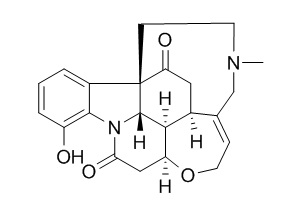Vomicine
Vomicine is a natural product from Strychnos nux-vomica, the S. nux-vomica extracts show antihyperglycemic activity in experimental animals.
Inquire / Order:
manager@chemfaces.com
Technical Inquiries:
service@chemfaces.com
Tel:
+86-27-84237783
Fax:
+86-27-84254680
Address:
1 Building, No. 83, CheCheng Rd., Wuhan Economic and Technological Development Zone, Wuhan, Hubei 430056, PRC
Providing storage is as stated on the product vial and the vial is kept tightly sealed, the product can be stored for up to
24 months(2-8C).
Wherever possible, you should prepare and use solutions on the same day. However, if you need to make up stock solutions in advance, we recommend that you store the solution as aliquots in tightly sealed vials at -20C. Generally, these will be useable for up to two weeks. Before use, and prior to opening the vial we recommend that you allow your product to equilibrate to room temperature for at least 1 hour.
Need more advice on solubility, usage and handling? Please email to: service@chemfaces.com
The packaging of the product may have turned upside down during transportation, resulting in the natural compounds adhering to the neck or cap of the vial. take the vial out of its packaging and gently shake to let the compounds fall to the bottom of the vial. for liquid products, centrifuge at 200-500 RPM to gather the liquid at the bottom of the vial. try to avoid loss or contamination during handling.
J Nat Med.2021, doi: 10.1007.
Cell Biochem Funct.2018, 36(6):303-311
Molecules.2019, 24(6):E1177
Asian J Beauty Cosmetol2021, 19(1): 57-64.
Molecules.2023, 28(2):727.
Food Funct.2021, 12(13):5892-5902.
Front Pharmacol.2021, 12:690113.
Materials Today Communications2023, 37:107216
Vietnam Journal of Science2022,64(2):69-75.
International J of Green Pharmacy2019, 13(3)
Related and Featured Products
Planta Med. 2000 Apr;66(3):262-9.
New antimalarial and cytotoxic sungucine derivatives from Strychnos icaja roots.[Pubmed:
10821054]
METHODS AND RESULTS:
Reinvestigation of Strychnos icaja Baillon resulted in the isolation of Vomicine, isostrychnine and of three new sungucine derivatives, named isosungucine (8), 18-hydroxy-sungucine (9) and 18-hydroxy-isosungucine (10). They were identified by detailed spectroscopic methods. The complete 1H- and 13C-NMR study of sungucine was also realized. Some of these compounds were highly active against Plasmodium falciparum in vitro and more particularly against the chloroquine-resistant strain.
CONCLUSIONS:
Compound 10 showed a selective antiplasmodial activity, with > 100-fold greater toxicity towards Plasmodium falciparum, relative to cultured human cancer cells (KB and HeLa lines) or fibroblasts (WI38).
Planta Med. 2012 Mar;78(4):377-82.
Antiplasmodial alkaloids from the stem bark of Strychnos malacoclados.[Pubmed:
22193980 ]
From the stem bark of Strychnos malacoclados, one new bisindole alkaloid, 3-hydroxylongicaudatine Y (1), was isolated along with the known alkaloids Vomicine (2), bisnordihydrotoxiferine (3), divarine (4), longicaudatine (5), longicaudatine Y (6), and longicaudatine F (7).
METHODS AND RESULTS:
All the compounds were tested for their antimalarial activity against the chloroquine-sensitive 3D7 and -resistant W2 strains of Plasmodium falciparum. Longicaudatine was the most active compound with IC₅₀ values of 0.682 and 0.573 µM, respectively. The activity of compounds 1, 3, 4, 6, and 7 against the two strains ranged from 1.191 to 6.220 µM and 0.573 to 21.848 µM, respectively. Vomicine (2), the only monomer isolated, was inactive. The alkaloids of the longicaudatine-type ( 1, 5-7) were more active than those of the caracurine-type (3- 4). The presence of the ether bridge in the molecule seems to increase the antiplasmodial activity. Compounds 1, 5, and 7 were tested against the WI-38 human fibroblast cell line. Longicaudatine was the most cytotoxic compound with an IC₅₀ of 2.721 µM.
CONCLUSIONS:
Longicaudatine F was 40-46 times more active against the two strains of P. falciparum than against the human fibroblasts and was thus considered as the more selective alkaloid. The structures of the compounds were determined based on the analysis of their spectral data.
J Ayurveda Integr Med. 2012 Apr;3(2):80-4.
Strychnos nux-vomica seeds: Pharmacognostical standardization, extraction, and antidiabetic activity.[Pubmed:
22707864 ]
Strychnos nux-vomica, commonly known as kuchla, contains strychnine and brucine as main constituents. Minor alkaloids present in the seeds are protostrychnine, Vomicine, n-oxystrychnine, pseudostrychnine, isostrychnine, chlorogenic acid, and a glycoside. Seeds are used traditionally to treat diabetes, asthma, aphrodisiac and to improve appetite.The present study was aimed to evaluate the various pharmacognostical characters and antidiabetic activity of S. nux-vomica seed.
METHODS AND RESULTS:
Pharmacognostical characters were performed as per the WHO guideline. Extraction was carried out in petroleum ether, chloroform, alcohol, hydroalcoholic, aqueous, and phytochemical constituents present in extracts were detected by different chemical tests. Among these extracts hydroalcoholic, aqueous extracts were evaluated for antidiabetic activity on the basis of extractive yield and phytoconstituents, in alloxan-induced diabetic rats using gliclazide as standard. Various analytical values of S. nux-vomica extract were established. Phytoconstituents present in S. nux-vomica extracts were detected.
CONCLUSIONS:
S. nux-vomica extracts show antihyperglycemic activity in experimental animals.
Alloisoimperatorin
Catalog No: CFN95012
CAS No: 35214-83-6
Price: $338/5mg
1,7-Diphenyl-5-hydroxy-4,6-hepten-3-one
Catalog No: CFN95171
CAS No: 87095-77-0
Price: $318/10mg
Cichoriin
Catalog No: CFN95196
CAS No: 531-58-8
Price: $100/20mg
(-)-Cadin-4,10(15)-dien-11-oic acid
Catalog No: CFN95246
CAS No: 1124353-23-6
Price: $318/5mg
Cannabiscitrin
Catalog No: CFN95278
CAS No: 520-14-9
Price: $318/5mg
Isovitexin-2''-O-rhamnoside (2''-O-alpha-L-Rhamnopyranosyl-isovitexin)
Catalog No: CFN95314
CAS No: 72036-50-1
Price: $368/10mg
4'-O-Methyllucenin II (Diosmetin 6,8-di-C-glucoside)
Catalog No: CFN95344
CAS No: 98813-28-6
Price: $318/10mg
2,11,12-Trihydroxy-7,20-epoxy-8,11,13-abietatriene
Catalog No: CFN95428
CAS No: 1608462-12-9
Price: $318/10mg
Maingayone B
Catalog No: CFN95483
CAS No: 1071223-57-8
Price: $318/20mg
8-Hydroxy-5,7-dimethoxyflavanone
Catalog No: CFN95580
CAS No: 201230-40-2
Price: $318/5mg



